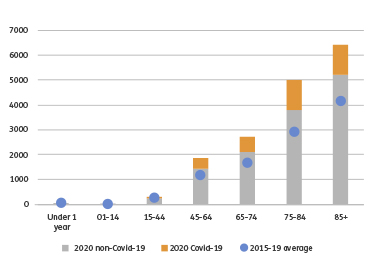As the death toll in the UK rises, behind every statistic is a person lost and a family devastated. We think of those people, while trying to understand how our actions and those of the Government are influencing how the coronavirus epidemic is progressing. There are various sources of numbers, says Dr Elizabeth Webb, and they don’t seem to add up. Why is this, and which sources can we trust?
The daily figures
The daily coronavirus mortality figures are discussed in the news each day as the number of people who have died of coronavirus during the previous 24 hours. However, this is not quite accurate: the daily figures are the number of deaths reported to the Department of Health and Social Care among patients who tested positive for coronavirus before they died. They include all deaths in hospitals in England reported by 5pm the day before, and deaths in Wales, Scotland and Northern Ireland wherever they occurred, if they were known to public health agencies.
These figures are released quickly, which provides an idea of how the coronavirus epidemic is progressing in the UK. However, they are not all the deaths from coronavirus in the previous 24 hours. Not everyone dies in a hospital, and not all those who die in hospital had a coronavirus test.
The weekly figures
We have recently started to see weekly figures on coronavirus deaths. These are compiled by the Office for National Statistics (ONS) and cover all deaths that happened in a week. The figures are released 11 days after the end of the week they occurred, and include deaths registered up to 3 days before the release. They include all deaths in England and Wales that include a mention of COVID-19 on the death certificate.
These weekly figures can be considered to be more accurate. They include deaths that happen in a hospital, at a person’s home, in a care home and elsewhere – where coronavirus is thought to be a cause of death whether or not there has been a test.
However, this source of information suffers because it has a time lag – when released they are for the week ending 11 days before – and so data is not timely enough for many of us. Also, even this source will not include all coronavirus deaths: although deaths should usually be registered within 5 days, this does not always happen. In the areas the coronavirus epidemic has hit hardest, it is taking longer than usual to register a death.
What's the most reliable information?
It’s clear these two sources of mortality figures are different, and that neither source is quite complete. The daily figures miss out more deaths but are timely; the weekly figures are more complete but come with a time lag. Neither, however, offers statistics for the whole of the UK. Both sources will, to some extent, underestimate the number of deaths from coronavirus, though both have their uses for helping to understand the epidemic.
The Government announced this week they are working towards being able to give definitive daily mortality figures. Whatever the Government’s efforts to produce this information, the debate will go on. Researchers will debate for years how coronavirus has affected mortality rates in the UK and there probably isn’t really a definitive answer, as the causes of a person’s death are often complex.
How do we decide what people have died of?
The ONS mortality figures include deaths that have been registered because they are compiled from the information given on death certificates. Death certificates are completed by doctors ‘to the best of their knowledge and belief’, and include both direct and underlying causes of death. There is, therefore, space for several causes to be listed. Guidance tells doctors a positive coronavirus test result is not necessary for coronavirus to be listed on a death certificate, and it can be put as either a direct or underlying cause of death. The coronavirus deaths counted by the ONS include all deaths where coronavirus is listed.
In England and Wales in the week ending 3 April 2020, coronavirus was included as a cause of 3,475 deaths.
Additional deaths
In that same week there were nearly 16,400 deaths from all causes. This is more than 6,000 more than the previous 5 years. Considering the 3,475 attributed to coronavirus, there were around 2,600 more deaths than would usually be expected at this time of year, over and above those attributed to coronavirus on the death certificate.


The graph on this page shows the number of deaths for each age group in England and Wales for that same week (ending 3 April 2020 – the most recent weekly data released by the ONS). These deaths are split into those where coronavirus was mentioned on the death certificate – the orange bars – and those that did not – the grey bars.
Also included on the graph is the average number of deaths in the equivalent week in the previous 5 years – shown using the blue spots. We can see that for every age group from 45-64 and older there were many more deaths in this week in the spring than had occurred in previous years. We can also see that only some of these deaths were due to coronavirus according to the death certificate. We are still trying to understand the causes of the extra deaths that have not been attributed to coronavirus, but they are likely to be caused by a combination of factors.
What caused the additional deaths?
Some of the extra deaths may be deaths from coronavirus that have not been recorded as such. When a death happens outside of a hospital, if a health professional has not recently seen the person who died and a coronavirus test was not done, sometimes the doctor certifying the death may be hesitant to put coronavirus as a cause. At Age UK we are worried about the people who are dying in care homes. Coronavirus testing in care homes is limited and because the NHS is currently so stretched, in many cases a doctor is not able to see the person to diagnose coronavirus before they die. Therefore, even if these deaths were caused by coronavirus, they may not be listed as such.
Some of the additional deaths may be people who didn’t have coronavirus but have died due to the wider circumstances of the epidemic. Some people who have been reluctant to go to hospital for health problems other than coronavirus, for fear of catching the virus or of over-burdening the NHS, may die of causes other than coronavirus. Their lives may have been saved had they sought medical attention, or sought it earlier.
There are also those who will die due to suicide, or violence, because of the strain caused by the social distancing measures. In the months and years to come we may also see deaths relating to poverty caused by the economic effects of our current circumstances.
At Age UK we are deeply concerned about the deaths of so many, mostly older, people.
We want those who need medical attention to seek it, whether their health problems are related to coronavirus or other causes. Throughout the coronavirus epidemic the NHS is still there for anyone who needs urgent care – call 111 for urgent care, or 999 in an emergency.
We want those who are struggling due to social distancing to be able to access help. The Silver Line is there for a chat, day or night, and the Age UK Advice Line offers free, confidential information and guidance.

More articles by Dr Webb
Dr Elizabeth Webb is a Senior Research Manager at Age UK. She has an MSc in Epidemiology from the London School of Hygiene and Tropical Medicine and a PhD in Social Epidemiology from University College London.
- What's the science behind the Government's guidelines?
- Can we predict how coronavirus will progress?
- Why are older people more at risk from coronavirus?
- How can we recognise when we have coronavirus?
- How close are we to a vaccine?
- What is R?
- How do we keep R below 1?
- What's the updated picture of coronavirus and older people?
- How can you assess your own risk from coronavirus?
- Is there an increased risk of coronavirus for BAME older people?
- What is k and who are the super-spreaders?

